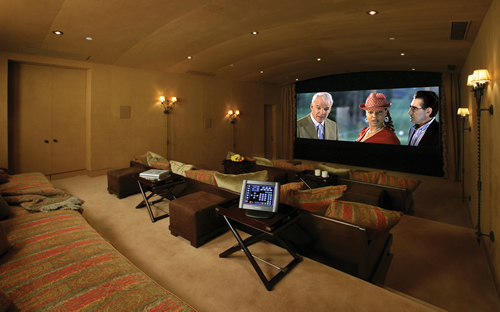October 2005
Structured Wiring Coming to a Living Room Near You
Consumers are finally migrating in large numbers to high-definition television, also known as "HDTV" or "hi-def" or just plain "HD." Although HDTV was conceived decades ago, it has only recently become economical and captured popular interest. Prices for plasma screens and other HDTVs are dropping to levels within reach of the average household. As a result, TV fans and home-theater aficionados everywhere have already entered the world of HD, and the average households will soon be joining them.
Running Home
HDTV is not just high definition but is also digital. Signals can be transmitted to an HDTV via high-bandwidth telecom and computer cables. The gold standard for home communications for the foreseeable future is structured wiring, which means the wires reach into separate rooms in a star pattern, or a home run configuration.
The old daisy chaining method of wiring is out and home runs are in. Daisy chaining (serial connection of outlets) is unsuitable for modern communications systems. The FCC prohibited that method of phone wiring in new construction way back in 2000.
In the home run configuration, wiring from each room is connected directly to a central distribution device (CDD). The central distribution device, in turn, is connected to various services, such as cable television, satellite television and a broadband Internet connection. Using this setup, the digital signals are easily routed to any room in the house, where HDTVs, sophisticated sound systems and other top-of-the-line entertainment-systems stand ready to deliver the goods to your eyes, ears and brain. The same system can also accommodate your home computer network, security, audio system and telephones.
Top Cats
A trip to any computer store or home center would quickly reveal that high-tech wiring today consists of Category 5e or Category 6 (Cat5e or Cat6) wires and quad-shielded RG-6 coaxial cables with an all-copper center conductor. These wires and cables can be bundled together and run through the walls, with separate terminations at faceplates, strategically placed throughout the home and built into the walls. These days it is not uncommon to find electronics and speakers built into the walls as well.
A veritable revolution is now happening with respect to technology in the home.
Hooking Up
Proponents of wireless systems may lead you to believe otherwise, but contrary to such rumors, structured wiring can be retrofitted into existing homes with minimal effort. Moreover, structured wiring assures compatibility and reliability, which may be lacking in wireless systems. Also consider that even wireless components must be plugged in someplace.
Special tools have been developed to run wires behind the walls of most homes, without tearing the walls open. This installation is probably not for an inexperienced do-it-yourselfer, but it can be done at a reasonable cost. Hiring someone to retrofit your existing home with structured wiring is well worth it.
New Jobs
The same company that installs your HDTV system probably can also offer a structured wiring system for select rooms of your home, or for your whole house. The HDTV business is redefining traditional trades, such as electricians, phone workers or cable installers. These new workers can quickly, efficiently and cost-effectively install the high-tech wiring system as well as the home-entertainment system of your dreams.
To get started immediately, call your local electrician or communications wiring installer. CDA offers consumers a checklist for structured wiring and for hiring a professional installer. You can find "Is Your Home Wired for the 21st Century?" at CDA's Telecommunications section. ![]()

